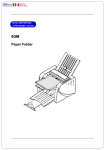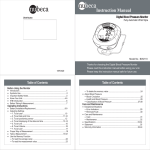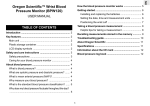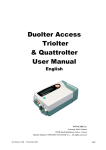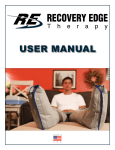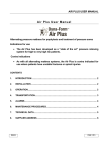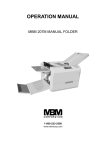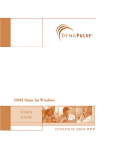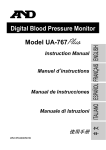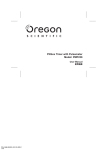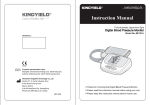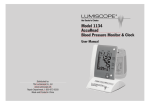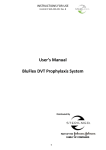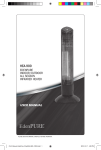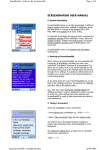Download PDF User`s Manual
Transcript
R Mo nitor e r u s s e r Blood P l a t i g i D uto Semi - A MS-702 MS-701K Important Notes........................................................2 Measurement Accuracy............................................2 Helpful Information...................................................3 Correct Method of Measurement..............................5 Parts Identification....................................................6 Description of Display Marks....................................6 Preparation before Taking a Measurement.............7 Taking a Measurement..............................................8 Memory Function (For MS-701K Only).....................9 Err Indicators / Troubleshooting...........................10 Care and Maintenance............................................11 Specifications.........................................................12 Blood Pressure Log................................................13 1 Only a physician is qualified to interpret changes in your blood pressure. The blood pressure measuring device bears the CE (conformity) label "CE 0044". The quality of the device This device is not intended to replace regular medical examinations. It is has been verified and conforms to the provisions of recom- mended that your physician review your procedure for the EC council directive 93/42/EEC of 14 June 1993 using this monitor. Never make adjustments to your on medical devices, as well as the EMC directive 89 medication unless it /336/EEC: is the advice of a physician. EN 1060-1 Non-invasive blood pressure measuring equipment General requirements EN 1060-3 Non-invasive blood pressure measuring equipment Supplementary requirements for electro-mechan ical blood pressure measuring systems EN 60601-1 Safety requirements for medical electrical equipment EN 60601-1-2 Electromagnetic compatibility and safety for medical electrical equipment EN 14971 Risk analysis for medical devices 2 What Is Blood Pressure? Typical daily blood pressure fluctuations Blood pressure is the force that blood exerts on the (Example : 35-year-old male) arteries. This force is constantly changing as the heart Blood Pressure (mmHg) beats. When the heart contracts, blood pressure reaches its highest value. This is called systolic blood pressure. When the heart relaxes between beats, the value of blood pressure is lower. This is called the diastolic blood pressure. The unit of measure for blood pressure is the millimeter of mercury, abbreviated mmHg. 160 systolic 100 diastolic 60 20 12 Lunch hour 15 18 Driving home Office hours 21 24 3 Sexual intercourse Family hours Sleeping 6 9 Time Driving to work Surgery hours For example, an individual's blood pressure may be measured as 120 mmHg (systolic) and 80 mmHg (diastolic). This would be spoken as "120 over 80" and written as What is High Blood Pressure? "120/80". Hypertension, or high blood pressure, is a condition where Remember that blood pressure varies throughout the an individual's blood pressure remains high over a long day. Food intakes, smoking, time of day, stress, level of period of time. Untreated, hypertension can cause many exercise and many other factors can affect it. serious medical problems including strokes and heart attacks. To control hypertension, the American Heart Association recommends that you not smoke, reduce fat and salt intake, maintain proper weight, exercise and get regular physical check-ups. 3 Blood Pressure Classifications Hints for Accurate Measurement 1. Relax and try to remain still for 5 to 10 minutes before a measurement. 2. Remove any clothing on the upper arm so that the cuff can be placed directly on the skin. Constriction of the upper Excessive arm caused by rolling up Constriction a shirt sleeve may cause and inaccurate reading. Avoid this condition by completely removing the garment causing the constriction. Seventh Why Is It Important to Measure Your Blood Pressure at Home? 3. Refrain from eating, smoking, and drinking (especially alcoholic beverages) before a measurement since these activities can affect your blood pressure. Having your blood pressure taken at the doctor's office may cause you to become nervous, thus artificially raising your reading. Having the ability to take your blood pressure at home makes it easy to record a log of your daily readings. 4. Remember that blood pressure varies continuously throughout the day. Try to take your blood pressure at the same time each day. This will help you gain a greater understanding of your blood pressure reading and the factors that affect it. Be sure that you share your information with your physician. 5. Do not be concerned with the results of one measurement. Many measurements, recorded over a long period of time, will provide a better indication of your 4 blood pressure. To obtain the most accurate blood pressure measurement, please follow these important directions. 6. Please relax for 5 to 10 minutes before taking another measurement. Be seated in a chair with back support. 7. Many factors can affect your blood pressure such as Rest your arm on a table so the cuff is at the same exercising, eating, talking, moving, nervousness, environment and temperature changes. level as your heart. Emotional Place both feet on the ground. stress can cause an increase in blood pressure. Daily fluctuations of 25 to 50 mmHg are common. Please note : Some individuals with hypertension, diabetes, kidney disorders, arteriosclerosis or poor circulation may see a significant difference in blood pressure readings taken from the wrist as compared to readings from the upper arm. It is recommended that you consult with your physician concerning the use of this monitor. IMPORTANT : The arm cuff must be at the same level as your heart, or accurate measurement will not be possible. (Your heart is located slightly below your left armpit.) 5 Monitor: 1 MS-701K Deflating 3 4 Inflating 2 1 LCD Display 2 Air Tube Socket 3 ON / OFF Button 4 MEMORY Button MS-702 Measurement Error Measuring 3 2 Accessories: for MS-701K Low Battery Exhaust Value Push Button Rubber Bulb Cuff Hose Arm Cuff for MS-702 6 Battery Installation / Replacement How to Apply the Wrist Cuff 1. Slide the battery cover off in (These directions are for either right or left hand measurements.) OPEN the direction of the arrow. 1. With your palm side up, apply the cuff so that the cuff's edge should be approximately 1cm from your palm. You can use the width of your forefinger as a simple way to measure the distance between the cuff and palm. 2. Install or replace the four batteries, noting the proper orientation of positive (+) and negative (-) terminals of the batteries in the battery compartment. 3. Replace the battery cover. 2. Do not apply wrist unit on top of a shirt sleeve. 4. If the Low Battery Symbol appears on the display, 3. Wrap the cuff snugly around your wrist and attach using the fastener. The top and bottom edges of the cuff should be tightened evenly 1 inch around your wrist. replace both batteries. 5. Remove the batteries if the unit will not be used for an extended period of time. 4. Any gap between the wrist and cuff will affect the result of measurement. Note : Batteries are hazardous waste. 5. The fabric cuff can be folded down for ease of viewing the display. Do not dispose them together with the household garbage. 7 ARTERY Palm Facing Up Please review the previous sections on proper placement of the cuff and proper arm position. 4. The unit will completely deflate when measurement is finished. The systolic, diastolic pressure and pulse will be displayed. 1. After the cuff has been properly placed on either the right or left arm, press the ON/OFF button. All symbols on the LCD display will appear momentarily. If you see a downward arrow symbol, press the exhaust valve located between the inflation bulb and the tube to release the residual pressure in the cuff. Note : The battery symbol will also appear at this time for checking power level. This does not indicate a low battery unless the low battery symbol remains on continuously. Systolic Diastolic Pulse rate If for any reason you would like to stop the measurement in progress, just press the exhaust valve to release the pressure and turn off the unit. 2. After "0" is displayed, you can pressurize the cuff by squeezing the bulb until the pressure value is 50 mmHg passed your suspected systolic pressure. If during a measurement the power drops to an insufficient level, the unit will end the measurement and display the low battery symbol. Please replace the batteries and repeat the measurement. 3. The unit will automatically deflate after you stop pressurizing the cuff. If you see an upward arrow symbol being displayed, that means you need to inflate the cuff to a higher pressure than you did the first time. If you do not see this symbol, it means it is taking your measurement. Please remain calm and still to avoid causing any measurement error. If the unit cannot detect your pulse, it will end the measurement attempt. Wait a few minutes, make sure that the cuff is positioned properly, and try again. The unit will automatically shut off 3 minutes following a reading, or it can be turned off manually by pressing the ON/OFF button. 8 Memory Input Memory Erase Your Automatic Digital Blood Pressure Monitor has a memory feature. When a valid measurement is made, the reading data (systolic, diastolic and pulse rate) will be stored in the memory automatically as soon as the unit is turned off, automatically shuts off, or when another measurement is initiated. When the batteries are taken out of the monitor, all records will be erased. Note : When taking a measurement, the MEMORY button is inactive. The unit has the capacity to store 7 readings, and also computes an average of up to the 7 memory readings. When more than 7 readings are taken and recorded to memory, the oldest ones will be deleted. Memory Recall By pressing the MEMORY button, you will see "A" in the lower left hand corner of the display. It means you are looking at the average of all the measurement results. Pressing the MEMORY button again, the newest set of measurement results is indicated by "1". Press it again, the next set will be displayed. Memory Number 9 Error Indicators Error indicator Troubleshooting Problem Possible sources of errors Recommended Action Indication: Cuff pressure reaches 330 mmHg. Cause: Twisted bladder inside of the cuff. Correction: Make sure that the bladder lays flat within the cuff. Nothing appears in display Make sure that the batteries are installed in the proper direction. (Polarity matches to the indications in the battery case.) No measurement occurs Check that the cuff is positioned properly. Go over the measurement procedure again. Indication: Display "Err", cuff pressure releases and "0" pressure display. Cause: Excessive arm movement or talking during measurement. Correction: Turn off and on the unit and measure again while keeping still. Blood pressure readings are too high or low Check if the wrist is positioned properly. Rest your arm on a table so that the cuff is level with your heart during measurement. Remain seated during the entire measurement period. Refrain from hand and body movements during measurement. Indication: Could not obtain pulse rate. Cause: Cuff was loosely applied, extremely weak pulse or arrhythmia. Correction: Reapply cuff and measure again. Blood pressure readings are variable Your blood pressure can fluctuate considerably through out the day. All of the following factors can influence your blood pressure: ¡@ Emotional state ¡@ Daily activities or exercise ¡@ Smoking ¡@ Drinking alcoholic beverages ¡@ Eating ¡@ Taking certain medications Batteries are exhausted. MS-701K: Replace with four new "AA" batteries. MS-702: Replace with four new "AAA" batteries. 10 11 Model: MS-701K / MS-702 Measuring method: Oscillometric Memory function: Storage and recall of 7 measurements with average (For MS-701K Only) Display: Digital LCD Measuring range: Pressure: 20 - 280 mmHg Measuring accuracy: Pressure: 3 mmHg Inflation system: Manual inflation with air pumping bulb Deflation system: Automatic deflation Arm size ranges: 22 - 33 cm ( 9 - 13 inches) Batteries: MS-701K : 1.5V (LR6/AA) x 4 Automatic power-off: Approx. 3 minutes after measurement Reference method for clinical trials: Auscultatory measurement Weight: Approx. 160 g (without batteries) Storage and transport condition: -10 C ~ +60 C, 10% ~ 95% RH Operating condition: +10 C ~ +40 C, 10% ~ 85% RH Standard cited 12 Pulse: 40 - 180 /minute Pulse: 5% MS-702 : 1.5V (LR3/AAA) x 4 Date Time mmHg 1/1 7:00 1/1 13:30 128 134 1/1 20:00 240 220 200 180 160 140 123 120 100 80 84 90 76 60 Pulse Body Condition 70 73 69 13 14 R 1U9-ED3 MBM-MS
















